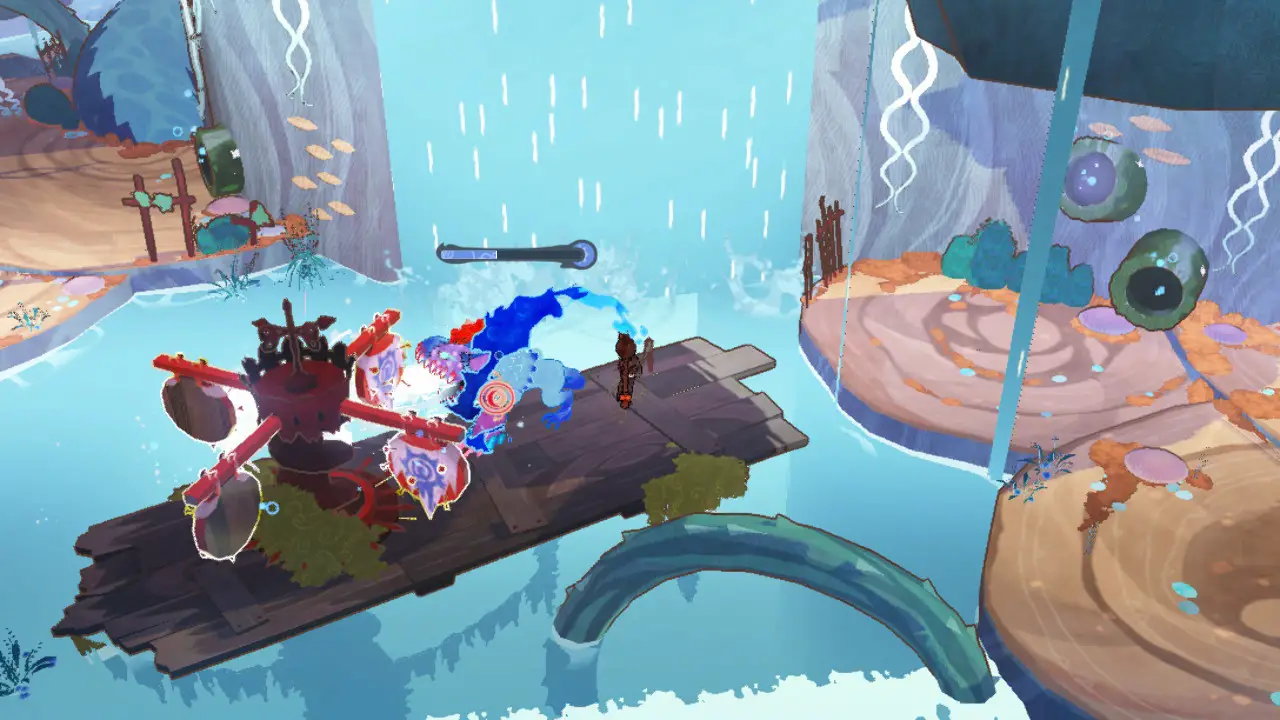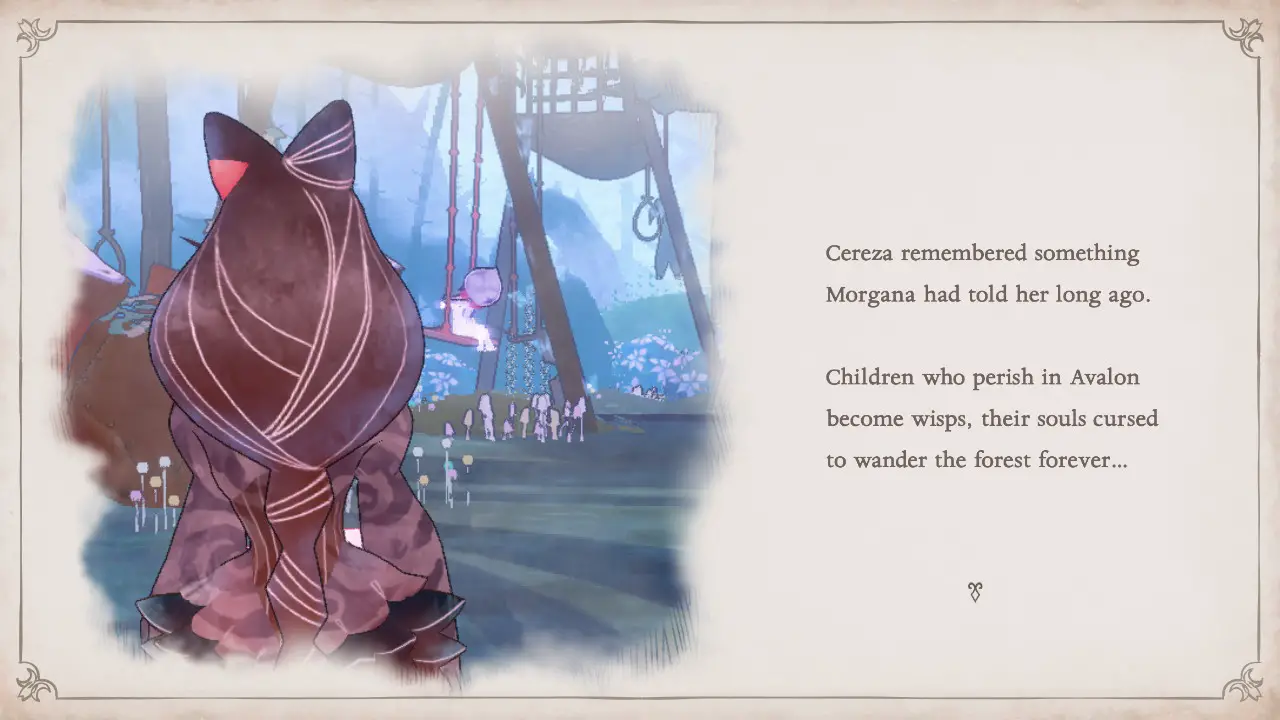
Before she became Bayonetta, Cereza was an Umbran Witch in training. The child of an Umbra Witch and Lumen Sage, she is a pariah among witches. With her mother in prison, Morgana has taken pity on the young girl and trains her outside the village. One fateful night, Cereza receives a vision in her dreams of a boy telling her that the power to save her mother lies in the nearby Avalon Forest; a labyrinthine maze rules over by the faeries. Inside, Cereza summons a demon to protect her, which takes up residence inside her stuffed cat, Cheshire. Unable to send the demon back to inferno, the two reluctantly team up to find whatever power lies within. But what awaits them will be much more than they bargained for…
I’ve made it no secret that I was very disappointed by Bayonetta 3. It’s not a bad game, but it didn’t feel like a Bayonetta game thanks to the focus on the Demon Slave mechanic. And don’t get me started on the story. Because of this, I was skeptical of the spinoff coming just a few months after. Bayonetta Origins: Cereza and the Lost Demon is a story focused prequel, exchanging the frenetic and deep combat for an exploration and puzzle game in which you control Cereza and Cheshire at the same time. Of course, I tried to go in with an open mind, and what I found quickly became one of my favorite games in the series.
Control of Cereza and Cheshire is split between the two halves of the controller. You use the left stick to move Cereza, press L to interact with the environment, and hold ZL to use her magic. Meanwhile, the right stick moves Cheshire, ZR attacks, and R interacts. As you progress through the story, you’ll unlock more moves like Hug Mode. Pressing L will have Cheshire revert to his plushie form, carried around by Cereza and regenerating his MP. Cheshire can then stretch out in any direction with the right stick to reach collectables, lightly punch things with ZR, and even fling the two over gaps with certain plants.
Destroying the story’s four elemental cores will grant Cheshire corresponding elemental forms. These change his attacks and give him access to special moves (R) like a grappling tongue or a ground slam. You swap between forms with A, B, X, and Y pressing the same button again to return to normal. Using a form will drain Cheshire’s MP, and running out will have him revert back to normal. While there are a few ways for him to regain magic on his own, the most common way is to return to Hug Mode.

In combat, Cheshire is the only one who can attack enemies, but if he takes too much damage he’ll revert to doll form. Conversely, Cereza can’t attack but will get a game over if her health runs out. Even if she can’t deal damage, she can still help Cheshire by binding enemies with thorns, allowing her demonic companion to wail on them. (She can also use items, but I only used health potions on the final bosses.) It’s a fun dynamic that, while not terribly deep, keeps you engaged and interested by having to keep track of two characters simultaneously. I imagine you could split up the joy-cons for some improvised co-op too, though I wasn’t able to try this myself.
While battles can occur normally in the world, most fights happen in Tír na nÓgs, a fae realm that Cereza and Cheshire need to clear to dispel illusions in the real world. Most of these are just arena battles, but there are several where you need to use the pair’s abilities to move forward. Some of these can even be repeated as time trials to unlock costumes.
As you fight, explore, and solve puzzles you’ll earn Onyx Rose petals and Avalon Drops, which can be spent at mirrors to unlock new abilities for Cereza and Cheshire respectively. You can unlock abilities like a powerful dual attack when an enemy is bound and Cheshire uses a charge attack, a devouring finisher, moving faster in hug mode when holding Cheshire in front of you, and much more. Some of these abilities do require Moon Pearls or Inferno Fruit which are hidden around the world. To find some of these, Cereza will need to send magic into objects like plants. Just like Thorn Bind, you do this by holding ZL, but in addition you’ll also need to move the left stick when a cursor reaches a moon. This gets more complicated later on needing you to hold a direction or press it twice. It’s a good way to bring the dancing Bayonetta is known for, this time in the form of ballet.
Bayonetta has historically gone for a more realistic style, but Origins looks more like a storybook. The gorgeous visuals have exaggerated features and cloth-like patterns on characters and objects that remain stationary while the characters move. (If you’ve seen Chowder on Cartoon Network, it’s like that.) I do find that all the colors can make battles occasionally difficult to parse, but it’s still an absolutely gorgeous game. Cutscenes are presented mostly with still 3D models posing like the “we ran out of money” cutscenes in Bayonetta 1 and 2, but with the book aesthetic it works a lot better here. Most everything is also fully voiced, with the narrator especially giving a fantastic performance even among the stellar work of everyone else.

The story as a whole is a lot of fun to see play out. From the start you know how Cereza and Cheshire’s relationship will progress along with a few other plot points like who the mysterious boy is, but there is an ending twist that I didn’t see coming. While Cereza starts off meek and easily spooked, it’s great to see her slowly make steps towards becoming the confident, take charge witch we know and love from 1 and 2. I will say that most ties the game has to the third entry only make that particular story worse, especially Jeanne’s side story here. While it’s always fun to play as the most powerful of the Umbra, the way things play out here just feels like twisting the knife of her poor treatment in 3.
It is worth noting that, while the rest of the series is rated M, Cereza dn the Lost Demon is rated T by the ESRB. Personally, I think this could be a great game to play with kids. It can get a bit dark at times, but no more than any Grimm fairy tales. It’s a great story about learning to overcome your fears and stand up for what you believe in.

Finally, The Lost Demon’s soundtrack trends more towards classical music, consisting mostly of piano. It fits the style wonderfully, and of course Fly Me to the Moon is worked in here as is tradition. This is one of those soundtracks I would absolutely buy on CD or Vinyl if Nintendo did that kind of thing in the US, but it is more understated and environmental than the main games’ tunes. It’s the cherry on top of a fun, inventive, and heartwarming adventure.
Bayonetta Origins: Cereza and the Lost Demon
Excellent
Bayonetta Origins: Cereza and the Lost Demon is a fantastic spinoff depicting an early adventure of a beloved character. Controlling both Cereza and Cheshire to solve puzzles and defeat faeries is a ton of fun, with a lot still left to discover even after the lengthy main story. This is a delightful start to what will hopefully be a fantastic sub-series.
Pros
- Amazing visuals and sound
- Great puzzles and combat
- A huge world to explore
- Good story
Cons
- Colorful visuals can make you lose track of characters in combat
